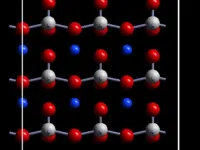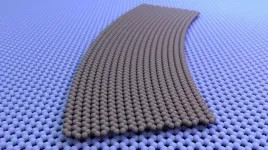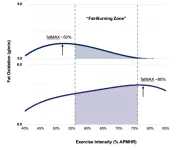(Press-News.org) UNIVERSITY PARK, Pa. — Systems in the Universe trend toward disorder, with only applied energy keeping the chaos at bay. The concept is called entropy, and examples can be found everywhere: ice melting, campfire burning, water boiling. Zentropy theory, however, adds another level to the mix.
A team led by Zi-Kui Liu, the Dorothy Pate Enright Professor of Materials Science and Engineering at Penn State, developed the theory. The “Z” in zentropy stands for the German word Zustandssumm, meaning ‘‘sum over states” of entropy. Alternatively, Liu said, zentropy may be considered as a play on the term “zen” from Buddhism and entropy to gain insight on the nature of a system. The idea, Liu said, is to consider how entropy can occur over multiple scales within a system to help predict potential outcomes of the system when influenced by its surroundings.
Liu and his research team have published their latest paper on the concept, providing evidence that the approach may offer a way to predict the outcome of experiments and enable more efficient discovery and design of new ferroelectric materials. The work, which incorporates some intuition and a lot of physics to provide a parameter-free pathway to predicting how advanced materials behave, was published in Scripta Materialia.
Ferroelectrics have unique properties, making them valuable for a variety of applications both now and in developing materials, researchers said. One such property is spontaneous electric polarization that can be reversed by applying an electric field, which facilitate technologies ranging from ultrasounds to ink-jet printers to energy-efficient RAM for computers to the ferroelectric-driven gyroscope in smartphones that enable smooth videos and sharp photos.
To develop these technologies, researchers need to experiment to understand the behavior of such polarization and its reversal. For efficiency’s sake, the researchers usually design their experiments based on predicted outcomes. Typically, such predictions require adjustments called “fitting parameters” to closely match real-world variables, which take time and energy to determine. But zentropy can integrate top-down statistical and bottom-up quantum mechanics to predict experimental measures of the system without such adjustments.
"Of course, at the end of the day, the experiments are the ultimate test, but we found that zentropy can provide a quantitative prediction that can narrow down the possibilities significantly,” Liu said. “You can design better experiments to explore ferroelectric material and the research work can move much faster, and this means you save time, energy and money and are more efficient.”
While Liu and his team have successfully applied zentropy theory to predict the magnetic properties of a range of materials for various phenomena, discovering how to apply it to ferroelectric materials has been tricky. In the current study, the researchers reported finding a method to apply zentropy theory to ferroelectrics, focusing on lead titanate. Like all ferroelectrics, lead titanate possesses electric polarization that can be reversed when external electric fields, temperature changes or mechanical stress is applied.
As an electric field reverses electric polarization reverses, the system transitions from ordered in one direction to disordered and then to ordered again as the system settles into the new direction. However, this ferroelectricity occurs only below a critical temperature unique to each ferroelectric material. Above this temperature, ferroelectricity — the ability to reverse polarization — disappears and paraelectricity — the ability to become polarized — emerges. The change is called the phase transition. The measurement of those temperatures can indicate critical information about the outcome of various experiments, Liu said. However, predicting the phase transition prior to an experiment is nearly impossible.
“No theory and method can accurately predict the free energy of the ferroelectric materials and the phase transitions prior to the experiments,” Liu said. “The best prediction of transition temperature is more than 100 degrees away from the experiment’s actual temperature.”
This discrepancy arises due to the unknown uncertainties in models, as well as fitting parameters that could not consider all salient information affecting the actual measurements. For example, an often-used theory characterizes macroscopic features of ferroelectricity and paraelectricity, but does not consider microscopic features such as dynamic domain walls — boundaries between regions with distinct polarization characteristics within the material. These configurations are building blocks of the system and fluctuate significantly with respect to temperature and electric field.
In ferroelectrics, the configuration of electric dipoles in the material can change the direction of polarization. The researchers applied zentropy to predict the phase transitions in lead titanate, including identifying three types of possible configurations in the material.
The predictions made by the researchers were effective and in agreement with observations made during experiments reported in the scientific literature, according to Liu. They used publicly available data on domain wall energies to predict a transition temperature of 776 degrees Kelvin, showing a remarkable agreement with the observed experimental transition temperature of 763 degrees Kelvin. Liu said the team is working on further reducing the difference between predicted and observed temperatures with better predictions of domain wall energies as a function of temperature.
This ability to predict transition temperature so closely to the actual measurements can provide valuable insights into the physics of ferroelectric material — and help scientists to better their experimental designs, Liu said.
"This basically means you can have some intuitions and a predictive approach on how a material behaves both microscopically and macroscopically before you conduct the experiments,” Liu said. “We can start predicting the outcome accurately before the experiment.”
Along with Liu, other researchers in the study from Penn State include Shun-Li Shang, research professor of materials science and engineering; Yi Wang, research professor of materials science and engineering; and Jinglian Du, research fellow in materials science and engineering at the time of the study.
The Department of Energy’s Basic Energy Sciences program supported this research.
END
Zentropy and the art of creating new ferroelectric materials
2023-08-11
ELSE PRESS RELEASES FROM THIS DATE:
Ribbons of graphene push the material’s potential
2023-08-11
Think you know everything about a material? Try giving it a twist—literally. That’s the main idea of an emerging field in condensed matter physics called “twistronics,” which has researchers drastically changing the properties of 2D materials, like graphene, with subtle changes—as small as going from a 1.1° to 1.2°—in the angle between stacked layers. Twisted layers of graphene, for example, have been shown to behave in ways that single sheets have not, including acting like magnets, like electrical superconductors, or like a superconductor’s opposite, insulators, all due to small changes in the twist angle between sheets.
In theory, you ...
New recycling process could find markets for ‘junk’ plastic waste
2023-08-11
MADISON – Although many Americans dutifully deposit their plastic trash into the appropriate bins each week, many of those materials, including flexible films, multilayer materials and a lot of colored plastics, are not recyclable using conventional mechanical recycling methods. In the end, only about 9 percent of plastic in the United States is ever reused, often in low-value products. With a new technique, however, University of Wisconsin–Madison chemical engineers are turning low-value waste plastic into high-value ...
The Israeli Override Clause: a threat to the health in all policies approach
2023-08-11
On July 24, 2023, Israel's Parliament sanctioned a substantial amendment to the Basic Law, prompting apprehensions regarding power equilibrium and its potential influence on public well-being. In response, a coalition of prominent Israeli and global public health experts has united to dissect the profound ramifications of this revision in an article titled “Israel's Judicial Overhaul: A Threat to the Health in All Policies Approach” featured in The Lancet.
The amendment, restricts ...
Indicator of PFAS found in some — but not all — period products
2023-08-11
SAN FRANCISCO, Aug. 10, 2023 — Period products come in a variety of styles — liners, pads, tampons, cups and underwear — to help people feel comfortable during a menstrual bleed. But their labels don’t usually list the ingredients, so consumers don’t know what’s in their product of choice. Now, researchers have analyzed over 100 period products for fluorinated compounds, an indicator of potentially harmful per- and polyfluoroalkyl substances, or PFAS. Their results show that while PFAS are absent from many products, ...
Exercise training and yoga can help improve lung function in adults with asthma
2023-08-11
Yoga and breathing control practices, in combination with aerobic training, are particularly key exercises for asthmatic people seeking to improve their lung function, a new peer-reviewed study suggests.
The research which is published today in the journal Annals of Medicine highlights the importance of integrating appropriate exercise training into asthma management plans.
The findings demonstrate just how effective specific types of exercise training can be to enhance lung function for those with adults, explains ...
Fat burning during exercise varies widely between individuals
2023-08-11
New York, NY [August 10, 2023]—The best heart rate for burning fat differs for each individual and often does not align with the “fat burning zone” on commercial exercise machines, Icahn School of Medicine at Mount Sinai researchers report.
Instead, the researchers said, clinical exercise testing—a diagnostic procedure to measure a person’s physiological response to exercise—may be a more useful tool to help individuals achieve intended fat loss goals. The study, which used a machine learning-based modeling approach, was published online today in Nutrition, Metabolism and Cardiovascular Disease.
“People with a goal of weight or fat loss may ...
The health impact of climate change is not adequately recorded: study
2023-08-11
A Monash University-led study has proposed a solution for the urgent need to capture real-time data on the impact of climate change-related events on human health, healthcare workforces, and healthcare systems at the point of care.
As the global community faces growing climate challenges, the study calls for action, collaboration, and innovation to safeguard human health and wellbeing in the face of environmental crises.
Published in the Journal of the American Medical Informatics Association, it highlighted key climate ...
New research shows genetic mutation known for Alzheimer’s disease is associated with higher fertility in women
2023-08-10
(Santa Barbara, Calif.) — Previous research has revealed that the Apolipoprotein-ε4 (APOE-ε4) allele increases the risk for a variety of diseases in aging populations, specifically Alzheimer’s and cardiovascular disease. And yet, despite the negative effects of this genetic variant, it remains prevalent in approximately 20% of the human population. In a quest to determine how this negative allele is surviving natural selection, a group of researchers have discovered that the APOE-ε4 allele is associated with higher fertility in women.
In a new paper released in Science Advances, researchers including UC Santa ...
Trinity research looks to Latin America for clues on healthy brain ageing
2023-08-10
Researchers at Trinity College Dublin study the factors influencing healthy brain ageing in Latin American and Caribbean (LAC) countries and find the lessons learned there, can also be applied to home.
Ageing is not a uniform process across the globe. Most research into cognitive and functional ageing has been conducted in the US and Europe, in high-income settings. Researchers from the Global Brain Health Institute (GBHI) at Trinity College are filling the knowledge gap that exists for Latin American populations on the factors ...
Transplant recipients experience limited protection with primary COVID-19 vaccination series, but third dose boosts response
2023-08-10
Key Takeaways
Lung and heart transplant recipients experienced diminished and delayed antibody responses to the first two COVID-19 mRNA vaccine doses, but most developed stronger responses following a third dose
A third dose also boosted cross-protection against SARS-CoV-2 viral variants
For lung and heart transplant recipients, vaccine doses beyond the third dose are likely important for maintaining immunity
BOSTON – Transplant recipients must take life-long immunosuppressive medications to prevent rejection, but these drugs ...




